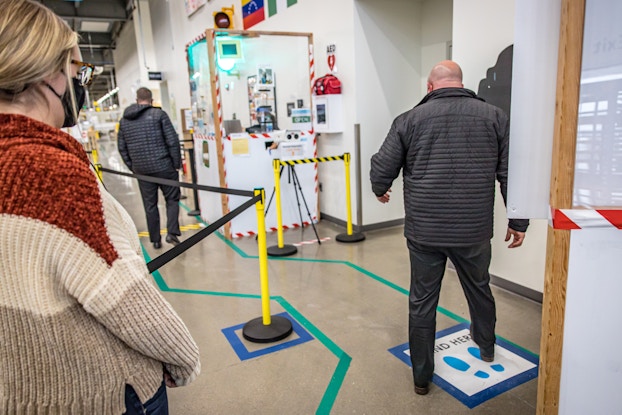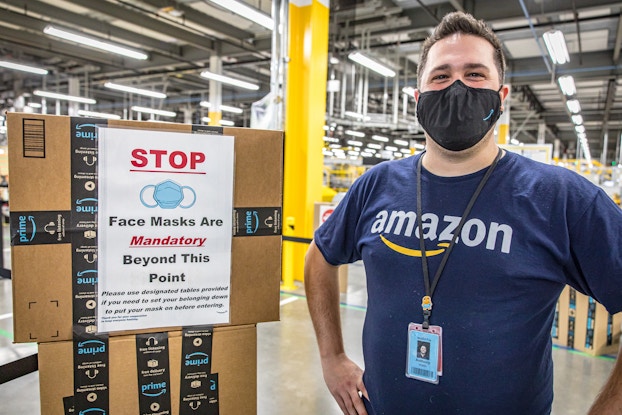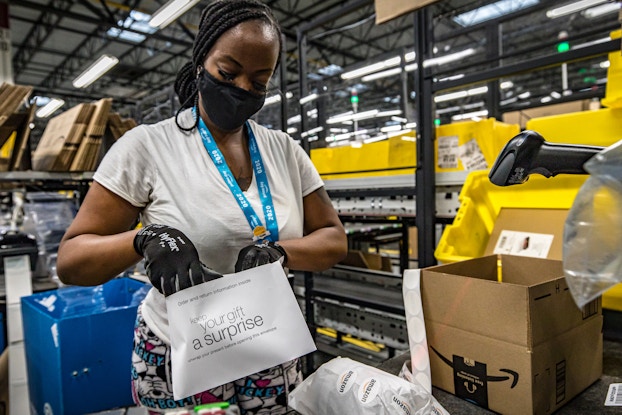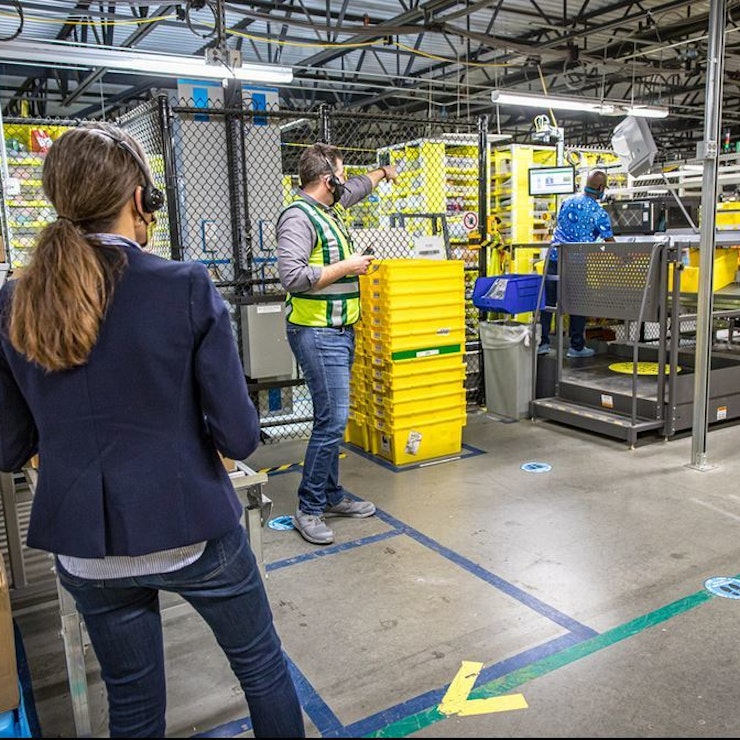As COVID-19 forced the world to shift heavily toward online shopping and home delivery services this year, customers had to be sure the workers handling their items were doing everything in their power to protect public health and safety.
Amazon, already a global e-commerce leader, knew its small business sellers and customers would turn to them to lead the way in safe business practices during this pandemic. That's why the company invested approximately $10 billion in COVID-related initiatives in 2020 to keep employees safe and get products to customers. The company also implemented more than 150 process changes — both high-tech and low-tech measures — including temperature checks, masks, gloves, enhanced cleaning and sanitization, extended pay and benefits options, on-site COVID testing and more.
But Amazon wanted to go beyond talking about its new safety investments and protocols. On November 5, 2020, the company partnered with the U.S. Chamber of Commerce to invite a small group of business owners to tour its Houston, Texas fulfillment center and give them a firsthand, behind-the-scenes look.
During this first stop on the company’s Safety Road Show and Education Series, Amazon showcased its leadership in COVID-19 safety measures and offered insights to help businesses navigate the challenges of the pandemic.

COVID-19 safety steps: What's been done so far
Guests who attended the Houston Safety Road Show participated in a socially distanced facility walkthrough and roundtable discussion to understand how Amazon protects and prioritizes the health and safety of the employees who handle the high volume of products that end up on customers' doorsteps. Small business owners were eager to understand the precautions Amazon takes, how it takes care of employees and what happens to their products once they send them to an Amazon fulfillment center.
There's no reason that the things that we've learned, and the investments that we've made, and the breakthroughs that we've had, cannot be shared and applied across other business owners.
Mike Stone, director of workplace health and safety for global customer fulfillment, Amazon

To answer that question, Mike Stone, Amazon's director of workplace health and safety for global customer fulfillment, discussed some of the 150-plus COVID-19 related process changes the company company made in 2020. Amazon has taken the following actions to ensure everyone involved in the fulfillment process — from sellers to employees to customers — is protected every step of the way:
- Added dedicated safety products, signage and staff members. Amazon has added masks, gloves, hand-washing stations, sanitizing products, thermometers, floor tape markers, educational signage and physical barriers to its facilities to promote health and social distancing. The company has also added thousands of janitorial staffers and redeployed more than 3,500 team members to become "social distancing ambassadors."
- Leveraged technology to ensure social distancing. In over 50 of Amazon's worldwide sites, an augmented-reality-based physical-distancing tool called Distance Assistant has been installed to help employees visualize what six feet of distance looks like. As employees walk past a Distance Assistant television screen, an AR "circle" will appear around them and change from green to red if they get too close to another employee. Amazon has open-sourced the software and AI behind this innovation so that anyone can create their own Distance Assistant. Individuals and businesses large and small can download the package at no cost and get up and running with just a computer and camera.
- Set up on-site COVID-19 testing for frontline employees. Amazon has built out sophisticated COVID-19 testing stations and labs at multiple U.S. sites to ensure every employee in these facilities has access to virus and antigen testing. "I thought that was just a step above and beyond," said Kennedy Lowery, a small business owner and Amazon seller who attended the safety event. "I haven't seen that at any other organization, for the associates to be able to come in and get tested. It really eased my mind as a seller ... just knowing that the people that are handling the products are being taken care of."
- Adjusted shifts and workflows to promote physical distance between employees. To reduce person-to-person interactions during shifts, Amazon has eliminated stand-up meetings, moved information sharing to bulletin boards, staggered break times and spread out chairs in its facility breakrooms. Amazon has also installed plexi-shields between work stations and throughout break rooms. Cleaning occurs across each site about every 90 minutes to sanitize door handles, stairway handrails, lockers, elevator buttons and touch screens.
These thorough and swift measures have already produced promising results: Amazon internally and publicly reports all employee COVID cases, and based on that data, Amazon employee COVID-19 infection rates are 42% lower than the rates of the general population.1

Small business safety lessons from Amazon
As Amazon steps up its safety game for the sake of its employees, vendors, sellers and customers, there's a lot to be learned about how to operate a safe and socially distanced business, even on a smaller scale.
"Some of the things that we've delivered for our own employees are very much applicable to small businesses across the globe," said Stone. "There's no reason that the things that we've learned, and the investments that we've made, and the breakthroughs that we've had, cannot be shared and applied across other business owners."
Diana Timmerman, a retail store owner, found the safety and sanitation protocols highlighted on the tour helpful, since she could take those strategies back to her own storefront.
"That's probably the biggest thing that I'll look at … how can we more diligent at cleaning and keeping it a safe environment?" Timmerman said.
Lawson Gow runs a chain of coworking spaces focused on supporting small and medium-sized businesses. Gow was impressed by Amazon's Distance Assistant technology — free, downloadable AI software available to any business to help inform and enforce social-distancing measures.
"The augmented reality technology that Amazon has implemented that keeps people reminded about the six-foot distancing was really cool," Gow said. "That is … something we actually might want to implement in our own facilities."

Here are a few important lessons for small businesses to take away from Amazon's practices:
- Every business process should be evaluated for the COVID-19 world. Ensuring safety ultimately comes down to analyzing all of your current business operations. Small businesses should break down each of their processes and look at them through the COVID-19 lens. This means figuring out where people are going and how they'll be interacting with each other on the premises and determining how they can do that while maintaining a safe distance, said Stone.
- Business owners need to practice what they preach. Businesses know they need to take COVID-19 safety seriously, but it's important that they enforce new policies and procedures at their physical locations and ensure that employees and customers are following them to the letter. "If they don't [adhere to safety protocols] as the business owner, it is your problem," Stone said. "You need to do everything you can to control that environment."
- Transparency with your employees and customers matters. Keeping employees safe during the pandemic and beyond is of the utmost importance, but it's only part of the equation. The other half of COVID-19 safety is ensuring transparency about your circumstances and policies, not only with employees, but with the larger public, said Stone. "If your employees know what is going on it builds trust with them, but also the general public as well," he said. "Everyone has got to be in this together. It's not just something that impacts your own business — it's going to impact outside of it very quickly as well. I want to see things return to some semblance of normalcy, and if we can do anything to educate the public on how best to do that, that’s great for everyone."
Learn more about Amazon's operational safety practices and how the company is continuing to evolve and respond to the pandemic on Amazon's COVID-19 blog.
1 Based on an analysis of data on all 1,372,000 Amazon and Whole Foods Market front-line employees across the U.S. employed at any time from March 1 to September 19, 2020.







